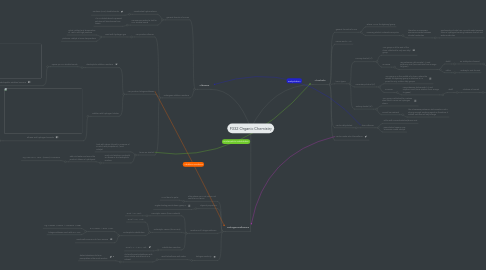
1. Alkenes
1.1. general formula of CnH2n
1.1.1. Unsaturated hydrocarbons
1.1.1.1. Contains (C=C) double bonds
1.1.2. Use Bromine water to test for C=C double bonds
1.1.2.1. If C=C double bond is present, solution will decolourise from brown
1.2. undergoes addition reactions
1.2.1. can produce alkanes
1.2.1.1. react with hydrogen gas
1.2.1.1.1. nickel catalyst and temperature of 150°C and high pressure
1.2.1.1.2. platinum catalyst at room temperature
1.2.2. can produce halogenoalkanes
1.2.2.1. electrophilic addition reactions
1.2.2.1.1. opens up C=C double bonds
1.2.2.2. additon with hydrogen halides
1.2.2.2.1. ethene and hydrogen bromide
1.2.3. forms an alcohol
1.2.3.1. heat with steam (at 300°C, pressure of 60 atm) with phosphoric(V) acid catalyst
1.2.3.2. react cold sulphuric acid with an alkene in an electrophilic reaction
1.2.3.2.1. add cold water and warm the product, alkene is hydrolysed
2. Halogenoalkanes
2.1. often shown as R-Hal, where Hal could be F,Cl,Br,or I
2.1.1. C-Hal bond is polar
2.2. Physical properties
2.2.1. Higher boiling points down group 7
2.3. Reactions of halogenoalkanes
2.3.1. Homolytic Fission (forms radicals)
2.3.1.1. R-Hal -> R''+Hal''
2.3.2. Heterolytic Fission (forms ions)
2.3.2.1. R-Hal -> R+ + Hal-
2.3.2.2. Nucleophilic substitution
2.3.2.2.1. R-X+NaOH -> ROH + NaX
2.3.2.2.2. reacts with ammonia to form amines
2.3.3. Substitution Reaction
2.3.3.1. R-Hal + X- -> R-X + Hal-
2.4. halogen reactivity
2.4.1. react haloalkanes with water
2.4.1.1. chrloro/bromo/iodoalkanes with silver nitrate and ethanol as a solvent
2.4.1.1.1. fastest substance to form precipitates is the most reactive
3. Alcohols
3.1. general formula of R-OH
3.1.1. where -OH is the hydroxyl group
3.1.2. meaning alcohol molecules are polar
3.1.2.1. therefore HYDROGEN BONDING exists between alcohol molecules
3.1.2.1.1. explains why alcohol can mix with water because there is hydrogen bonding between alcohol and water molecules
3.2. names end in "-ol"
3.3. has 3 types
3.3.1. Primary alcohol (1°)
3.3.1.1. -OH group is at the end of the chain, attached to only one alkyl group
3.3.1.2. OXIDISE
3.3.1.2.1. use potassium dichromate (VI) and sulphuric acid (turns solution from orange to green)
3.3.2. Secondary alcohol (2°)
3.3.2.1. -OH group is in the middle of a chain, where the carbon the hydroxyl group is attached to is joined to only 2 other alkyl groups
3.3.2.2. OXIDISE
3.3.2.2.1. use potassium dichromate (VI) and sulphuric acid (turns solution from orange to green)
3.3.3. Tertiary alcohol (3°)
3.3.3.1. -OH group is attached to a carbon atom which carries no hydrogen atoms
3.3.3.2. cannot be oxidised
3.3.3.2.1. this is because potassium dichromate is not a strong enough oxidising agent so therefore, if added, solution will stay orange
3.4. can be dehydrated
3.4.1. forms alkenes
3.4.1.1. reflux with concentrated sulphuric acid
3.4.1.2. pass alcohol vapour over aluminium oxide catalyst

